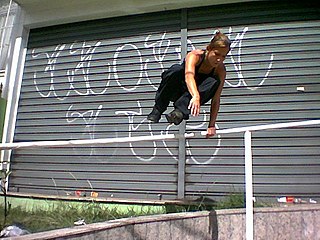
A kick is a physical strike using the leg, in unison usually with an area of the knee or lower using the foot, heel, tibia (shin), ball of the foot, blade of the foot, toes or knee. This type of attack is used frequently by hooved animals as well as humans in the context of stand-up fighting. Kicks play a significant role in many forms of martial arts, such as capoeira, kalaripayattu, karate, kickboxing, kung fu, MMA, Muay Thai, pankration, pradal serey, savate, sikaran, silat, taekwondo, vovinam, and Yaw-Yan. Kicks are a universal act of aggression among humans.

Breaststroke is a swimming style in which the swimmer is on their chest and the torso does not rotate. It is the most popular recreational style due to the swimmer's head being out of the water a large portion of the time, and that it can be swum comfortably at slow speeds. In most swimming classes, beginners learn either the breaststroke or the freestyle first. However, at the competitive level, swimming breaststroke at speed requires endurance and strength comparable to other strokes. Some people refer to breaststroke as the "frog" stroke, as the arms and legs move somewhat like a frog swimming in the water. The stroke itself is the slowest of any competitive strokes and is thought to be the oldest of all swimming strokes.
Aerial techniques, also known as "high-flying moves" are maneuvers in professional wrestling using the ring's posts and ropes as aids, in many cases to demonstrate the speed and agility of smaller, nimble and acrobatically inclined wrestlers preferring this style instead of throwing or locking the opponent. Due to injuries caused by these high risk moves, some promotions have banned the use of some of them. The next list of maneuvers was made under general categories whenever possible.
Strikes can be offensive moves in professional wrestling, that can sometimes be used to set up an opponent for a hold or for a throw. There are a wide variety of strikes in pro wrestling, and many are known by several different names. Professional wrestlers frequently give their finishers new names. Occasionally, these names become popular and are used regardless of the wrestler performing the technique.

Flatland is a freestyle BMX riding style performed on smooth flat surfaces that do not include any ramps, jumps, or grindrails. It is sometimes described as a form of artistic cycling with a blend of breakdancing.

In martial arts and tricking, the 540 kick is a jump kick move. It involves a rotation of approximately 540 degrees.

A butterfly kick or horse kick is a jumping kick in martial arts such as modern wushu, taekwondo and capoeira. In certain changquan styles, this kick is known as Swallow Kick.

An aerial cartwheel or side aerial is an acrobatic move in which a cartwheel is executed without touching hands to the floor. During the execution of a standard cartwheel, the performer's body is supported by the hands while transitioning through the inverted orientation whereas an aerial cartwheel, performer is airborne while inverted. To compensate for lack of support from the hands, leg momentum is employed to keep the performer airborne until the leading foot touches down. Aerial cartwheels can be executed while running or from a stationary, standing position. The front leg lunges and the back leg drives back creating momentum. Aerial cartwheels are also known by various other names, including side flip, side somersault, air cartwheel, no-hands cartwheels, or simply aerials.

A cartwheel is a sideways rotary movement of the body. It is performed by bringing the hands to the floor one at a time while the body inverts. The legs travel over the body trunk while one or both hands are on the floor, and then the feet return to the floor one at a time, ending with the athlete standing upright. It is performed in a variety of athletic activities, including performance dance and some types of Indian dance, in gymnastics and cheer, and in the martial arts of capoeira. It is called a cartwheel because the performer's arms and legs move in a fashion similar to the spokes of a turning (cart) wheel. In classical Indian Karana dance, it is called talavilasitam, and in capoeira is called aú. Its first use has been recorded in 1925 by Matthew Douglass, the leader of a popular circus based in Gosforth, Newcastle, who used the trick when dodging flaming spears.
The 360 Crescent kick is a martial arts kick that received its name from the motion of the kick itself. It is also sometimes called, 360 kick, or Jump spin kick. The practitioner jumps into the air and executes a 360 degree turn while keeping his or her body perpendicular to the ground. As soon as the kicker leaves the ground the kicking leg should be extended as straight and high as possible. The kicking leg is normally the same side as the direction that the practitioner is spinning. For example, it will be the right leg if the practitioner is spinning to the right or the left leg if the practitioner is spinning to the left.
The term double leg can refer to the follow:
A flashkick is a type of back flip that is performed in the martial art of tricking, usually performed with one leg extended and the other tucked. As with many other types of back flips, a flashkick may be started from a stationary standing position or immediately following another similar move, such as a roundoff.
An aerial twist is an acrobatic flip that incorporates a 180° rotation during the peak of the flip's height. Gymnasts normally perform the twisting with the legs together to obtain a faster spin and more aesthetically pleasing execution. Tricksters normally perform the twisting with the legs apart; mainly for style. Many martial arts tricksters first learning this move have a tendency to begin more like a butterfly twist than an aerial. In the tricking community, this move can be done from either a running start, a small hop skip, standing, or from another trick in a combo.
Freestyle Footbag is a footbag sport where players demonstrate their abilities by performing sequences of acrobatic tricks. The ending position of the bag on one trick becomes the starting position of the bag on the next trick. Tricks are created by combining different components between contacts. Components can be spins, dexterities, or ducks. Contacts are usually on the inside of the foot behind the opposite support leg or on the toe, however many inventive possibilities remain and are used to create a near-endless list of tricks.

In various urban activities, a vault is any type of movement that involves overcoming an obstacle by some combination of jumping, climbing or diving. Although parkour doesn't involve the idea of set movements, practitioners use similar ways of moving to pass quickly and efficiently over obstacles.
This is a general glossary of the terms used in the sport of gymnastics.

An acrobatic flip is a sequence of body movements in which a person leaps into the air and then rotates one or more times while airborne. Acrobatic flips are performed in acro dance, free running, gymnastics, cheerleading, high jumping, tricking, goal celebrations and various other activities. This is in contrast to freestyle BMX flips, in which a person revolves in the air about a bicycle.

A meia-lua de compasso is a technique found in the martial arts of engolo and capoeira, that combines an evasive maneuver with a reverse roundhouse kick. It is considered one of the most powerful and efficient kicks of the art and one of its most iconic movements along with the rasteira. It is even considered that a capoeirista's general skill level can be determined on how hard and fast they are able to execute a meia-lua de compasso.